World News
al-Shifa hospital after Israel’s withdrawal

Yolande Knell,Rushdi Abu Alouf
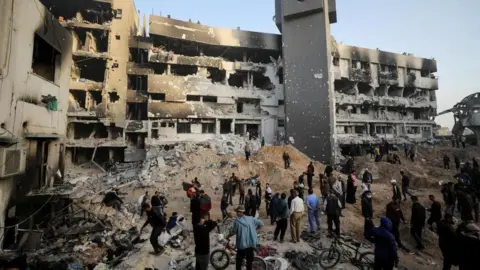 Reuters
ReutersAfter Israeli forces pulled out of Gaza City’s vast al-Shifa hospital complex on 1 April, following their second raid there, stunned Palestinians who pored over the burnt-out ruins said it reeked of death.
During the past eight months of war, hospitals have come under repeated attack, with Israel claiming they are used as bases by Hamas; something the group denies.
But events at al-Shifa – once the biggest and best equipped medical facility in the Gaza Strip – have arguably been the most dramatic.
The two-week surprise raid, launched after Israel said Hamas had regrouped at the site, was described by the Israeli government as “precise and surgical”.
Its spokesman, Avi Hyman, asserted that it had set “the gold standard of urban warfare”. He said: “We took out over 200 terrorists. We apprehended over 900 terrorists with not a single civilian casualty.”
With decaying bodies sticking out of the sand piled up by combat bulldozers in the courtyards of al-Shifa, the claim that there had been no civilian casualties was immediately questioned.
In recent weeks, four mass graves have been uncovered at the site, with Palestinian search teams saying that several hundred bodies have been found.
We have worked with a journalist in Gaza to follow developments.
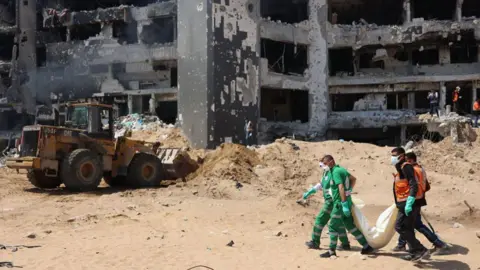 Getty Images
Getty Images“We’ve extracted martyrs, many of whom are decomposed and completely unidentifiable,” a Palestinian Civil Defence worker, Rami Dababesh told us grimly on 8 May as he stood by a line of white plastic body bags at al-Shifa, wearing a face mask and full protective gear.
“We’ve found corpses of women, children and individuals without heads as well as torn body parts,” he added.
The Civil Defence lacks forensic equipment and expertise, but its teams have been using photos and videos to document the remains. A director, Dr Mohamed Mughir, told us there were suspicious finds; describing how “signs of field executions, binding marks, gunshot wounds to the head and torture marks on the limbs were observed on the bodies of some martyrs”.
The UN Security Council has expressed “deep concern” at the discovery of mass graves at both al-Shifa and Nasser hospital in southern Gaza. Along with the US and the European Union, it has called for an independent investigation into possible war crimes.
The Israel Defense Forces (IDF) says that during its raids of the Gaza hospitals, its soldiers exhumed bodies that Palestinians had buried earlier as part of its search for the remains of some 250 hostages captured during the deadly Hamas attacks on Israel on 7 October.
It maintains bodies were examined respectfully and those not belonging to Israeli captives were returned to their place.
However, at least some of the corpses found recently at al-Shifa were those of patients who died during Israel’s latest military action. A paramedic involved in the search said some had IV catheters still attached.
On 15 April, the BBC met two men whose dead mothers were last seen being treated at the hospital. Their bodies had just been recovered from a mass grave.
“I came running here when they told me of the grave,” said Mohammed al-Khatib, who had spent days searching for his mother, Khawla. “By the grace of almighty God her body was found.”
Walid Fteima said his elderly mother, Lina Abu Leila, was being treated for malnutrition and severe dehydration when she died. Her body was decomposed, and he could only identify her from injuries she had from an Israeli bombing last year. “[She] had a toe amputated on each foot,” he explained.
After it began its operation at the hospital early on 18 March, the IDF ordered thousands of civilians sheltering there and living in the vicinity to leave and head south. However, it said the hospital could continue to function. By the end of two weeks, only some 140 patients and medics reportedly remained.
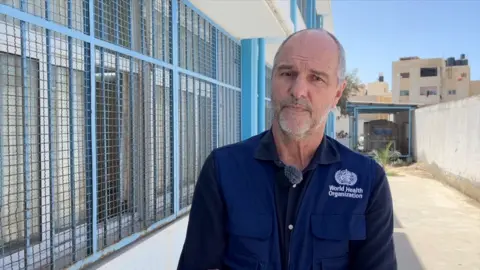
The local WHO representative, Dr Rik Peeperkorn, says this group endured “horrific conditions”. After being repeatedly moved around the complex, he says, they “actually ended up in the human resources building which was completely unfit for treatment”. Ultimately, he says, 20 patients died.
Several surviving patients – all wounded in previous Israeli strikes – told us they were given only tiny quantities of food such as canned tuna. They said there were severe shortages of drinking water and medication.
“The bombing surrounded us 24/7,” said Mohamed al-Nadeem who is half paralysed. “I am sick and unable to move. I was sleeping on the floor without blankets.”
“There were no dressings or painkillers,” said Rafif Doghmush, 15, whose foot has been amputated.
The IDF has told journalists that no staff or patients died as a “direct result” of its action, but that some may have died of “natural causes”.
During its raid, it said it helped patients by moving them out of harm’s way and that medical supplies and devices as well as food, water, and a generator were brought to the hospital.
Grainy drone footage shared by the IDF after it launched its raid on 18 March showed Palestinian gunmen apparently shooting at soldiers from inside al-Shifa hospital. Later, the gunmen were said to have barricaded themselves in wards and corridors, opening fire and throwing explosives.
Three Israeli soldiers were confirmed to have been killed during the two-week long operation.
The IDF briefed journalists that its action at the hospital was taken based on “concrete intelligence” that Hamas and Palestinian Islamic Jihad had taken over parts of the site, suggesting their operatives had been using it to access basic supplies as well as power and the internet.
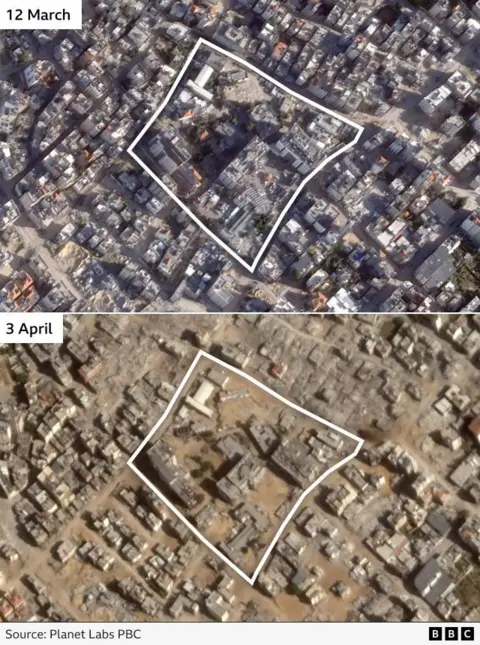
While Hamas denied using al-Shifa as a base, its officials did not deny the presence of some members inside the complex, indicating that they may have been among displaced people sheltering there.
Israel has said that “over 200 terrorists” were killed in and around al-Shifa, as well as the hundreds detained, but has only given some names.
These include Faiq al-Mabhouh, described as head of operations in Hamas’ internal security service. The Hamas-run government’s media office said he was a police commander who had been co-ordinating aid deliveries to northern Gaza.
Others killed were identified as a senior Hamas commander, Raed Thabet, said to have been head of recruitment and supply acquisition, and Mahmoud Zakzouk, said to have been deputy commander of the Hamas rocket unit in Gaza City. Two other Hamas operatives were named as Fadi Dweik and Zakaria Najib, said to have been involved in organising attacks in the occupied West Bank.
In April, the IDF also released footage which it said was from the interrogation of Tarek Abu Shaluf, spokesman for the political wing of Islamic Jihad. It said he had been captured at al-Shifa.
Hamas and Islamic Jihad do not routinely confirm the names of low-level fighters killed by Israeli military action, making it very difficult to estimate how many were killed at the hospital and in the vicinity. It is likely that a number were among the dead found in mass graves.
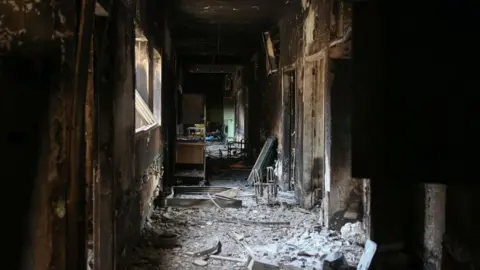 Getty Images
Getty ImagesDespite the Israeli claim that there was “not a single civilian casualty” from its raid, we have been given strong testimony that there were Palestinian civilians killed by heavy Israeli bombardment and intense shooting in the surrounding neighbourhood.
The Palestinian Civil Defence told us that hundreds of Palestinians were still reported to be missing following the raid in March.
There have repeatedly been conflicting narratives about what has happened in and around al-Shifa.
During its first controversial raid there, the Israeli military raised expectations that Israeli hostages might be found at the site. It also released a graphic depicting a vast underground tunnel network that it suggested was underneath the hospital, serving as a major Hamas command and control centre.
While the IDF said it retrieved the bodies of two Israeli hostages near to the hospital, it did not announce that it had found any within the complex. Security camera footage that was recovered did show that at least two foreign captives were taken there on 7 October.
The IDF showed what it said was a fortified 55-metre tunnel on the hospital grounds. This fell short of its initial claims about the extent of hidden tunnels, although later reporting suggested the passage – which was blown up – had actually been longer and was most likely connected to a wider network under Gaza City.
When it returned to the site in March, the IDF suggested its key discoveries were of a different nature, releasing pictures of cash, weapons, and ammunition it said it had found there along with Hamas documents.
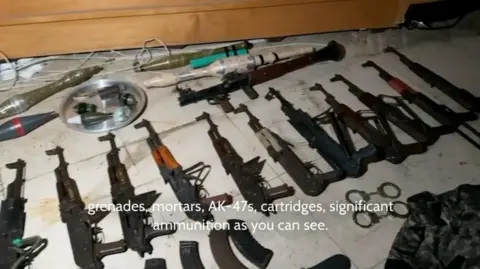 IDF
IDFAl-Shifa has been at the heart of a debate about whether Hamas uses medical sites as a cover. Israel has consistently claimed that the group hides its fighters and infrastructure behind the sick and wounded, which it suggests has rendered hospitals legitimate military targets.
Hamas denies misusing civilian sites and accuses Israel of violating international humanitarian law by targeting hospitals.
In April, when the UN called for “a clear, transparent and credible investigation” of mass graves in Gaza, its spokesman Stephane Dujarric told reporters that more journalists needed to be able to work safely in the territory to report on the facts. During the war, Israel and Egypt have denied free access to foreign media.
Mr Dujarric also said: “It’s important that all forensic evidence be well preserved.” So far, that is proving to be a challenge.
International forensic specialists have been unable to reach Gaza to investigate what happened at al-Shifa. That has left much of the focus locally on registering and identifying the dead where possible, and giving them proper burials.
The disturbance of the mass grave sites, experts say, will ultimately make it much harder to uncover the truth about them.
Meanwhile, although al-Shifa has been largely destroyed, there have been recent efforts to restart very limited medical services on site. These gained momentum as Israel targeted other health facilities which it said were being used by Hamas, particularly Kamal Adwan Hospital in northern Gaza.
In late May, in a hastily repaired room of the kidney dialysis unit at al-Shifa, the journalist working with us met four patients as they sat connected to steadily beeping machines. After so many deaths at the hospital, it is once again providing some life-saving treatment.
World News
New Jersey man with epilepsy uses hand-painted seashells to help find a cure

Greater epilepsy awareness could be as simple as a walk on the beach, thanks to one New Jersey man.
Kyle Adamkiewicz, 33, has lived with epilepsy since being diagnosed at age 6. He is now combining his love of art with the power of nature to help bring his seizure disorder into the spotlight.
In Oct. 2022, Adamkiewicz began collecting seashells from the New Jersey shore, then painting and decorating them with heartfelt messages in search of a cure. He places his works of art along the seaside boardwalks in the hopes that they will inspire strangers to spread the word — and the shells.
OHIO WOMAN WITH EPILEPSY FINDS SAFETY WITH HER SERVICE DOG
“It started with just painting a few shells, and I figured no one would find them,” Adamkiewicz said in an interview with Fox News Digital.
“And then I saw people posting them online, and writing so many good and positive comments about the shells and about finding a cure for epilepsy. That motivated me to keep making more and more and more.”

Kyle Adamkiewicz, shown above, now 33, has lived with epilepsy since he was diagnosed at age 6. He is combining his love of art with the power of nature to help raise awareness of his disease. (Adamkiewicz family)
“And now they have been around the entire world.”
Adamkiewicz doesn’t drive, so his parents — Chuck and Laurie Adamkiewicz — drive him to place his shells.
“We have shells with us in the car all the time, and he places them in different locations, different towns,” his mother told Fox News Digital.
Adamkiewicz estimates that he’s painted some 1,100 shells so far.
Many include messages about finding a cure for epilepsy, but he has also created themed designs for various occasions, like Shark Week and Halloween.
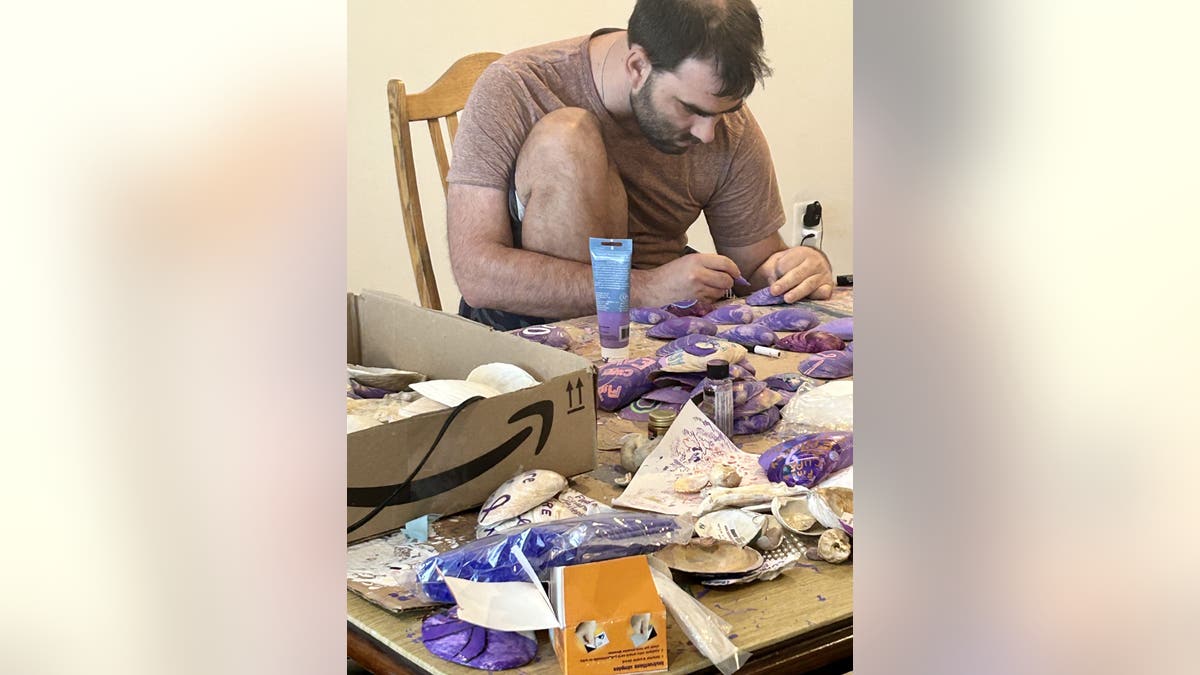
Adamkiewicz has painted over 1,000 shells so far. “Our entire living room consists of nothing but shells and paint,” joked Adamkiewicz’s mother. (Adamkiewicz family)
“Our entire living room consists of nothing but shells and paint,” joked Adamkiewicz’s mother.
In addition to a hand-painted design, each shell contains Adamkiewicz’s initials, the year he decorated it and a QR code.
When people find the shells and scan the QR code, it takes them to a website. From there, they can access Adamkiewicz’s Facebook group, his Instagram account and a GoFundMe page set up to help raise funds for people to get “seizure alert” dogs.
THE GIRL WHO CAN’T SMILE: HOW A RARE DISORDER BECAME A YOUNG WOMAN’S ‘GREATEST GIFT’
It also links to the Epilepsy Foundation website, where people can learn what to do if they witness someone having a seizure.
“Most people don’t really know how to handle someone if they’re having a seizure,” Adamkiewicz told Fox News Digital. “They just turn their back and walk the opposite way.”

In addition to a hand-painted design, each shell contains Adamkiewiczs’s initials, the year he decorated it and a QR code. (Adamkiewicz family)
“One out of 26 people in the world have epilepsy, but it’s basically a hidden disease that nobody really wants to know about.”
The Adamkiewicz family has a map of the world hanging on the wall — with pushpins to mark where the shells have been found, they told Fox News Digital.
In addition to locations across the U.S., shells have also been scanned in Mexico City, Greece, Italy, Panama, Canada, Nova Scotia, France, South Korea and Germany, Adamkiewicz said.
“One out of 26 people in the world have epilepsy, but it’s basically a hidden disease.”
“People will find the shells and take them to those places,” Adamkiewicz said. “And sometimes people will ask me for shells to take to wherever they are traveling.”
He’s also partnered with the hospital to get kids with epilepsy involved in his project, bringing shells in for them so they can paint their own designs.
Touching lives
Beyond helping to find a cure, Adamkiewicz has a goal of reducing bullying of people with epilepsy.
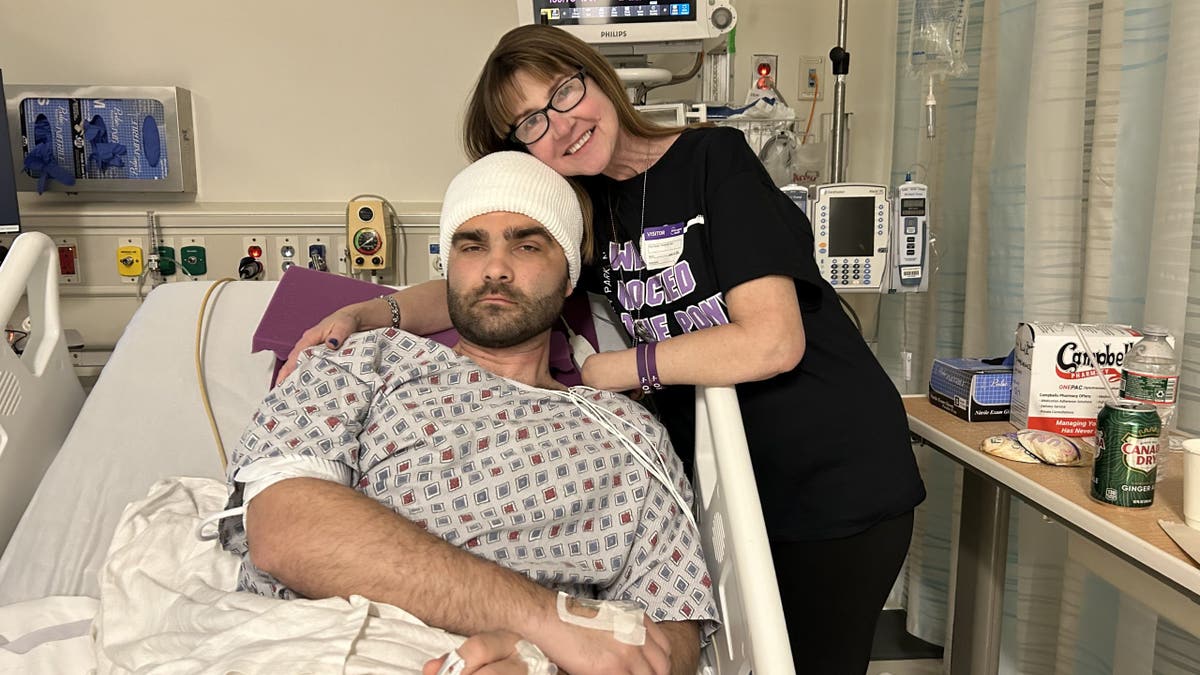
Adamkiewicz is pictured with his mother, Laurie Adamkiewicz. In April, he underwent a procedure to implant a responsive neurostimulation (RNS) device in his brain, which will gather data about his seizure activity. (Adamkiewicz family)
“When I was growing up, if my parents or brother weren’t there, I was always made fun of in school and in the neighborhood,” Adamkiewicz said. “Especially right after I had a seizure — the kids would just stare at me and make fun of me.”
He went on, “I want people to know it’s OK to be friends with someone with epilepsy.”
OHIO BOY, 8, PREPARES FOR BLINDNESS: ‘IT’S HEARTBREAKING,’ HIS MOM SAYS
At one point, during second and third grade, he estimates that he was having 100 seizures per day.
“It’s been a very hard and lonely life for Kyle, and very painful to see as a mother and father,” Laurie Adamkiewicz added.
The goal, she said, is that the shells will help to make life a little easier for those with epilepsy — and their families.

Adamkiewicz said his seashell project has been a therapeutic endeavor for him. “If it’s been a really bad day, that’s mostly what I’ll be doing,” he said. (Adamkiewicz family)
Adamkiewicz’s mother recalled a man who posted about a personal experience on the Facebook group.
“His son had passed away, and the man goes to the ocean every morning to say good morning to his son,” she said. “And there was the epilepsy shell, and he said he started crying. He said it was just like a gift to him.”
She added, “You never know whose lives you’re touching.”
Taking control
Since age 12, Adamkiewicz has been a patient at NYU Langone’s Comprehensive Epilepsy Center, one of the largest programs in the nation, where he’s had a series of brain surgeries.
NEW JERSEY TWINS RECEIVE MATCHING HEART SURGERIES AFTER MARFAN SYNDROME DIAGNOSIS: ‘A BETTER LIFE’
In April, he underwent a procedure to implant a responsive neurostimulation (RNS) device in his brain, which will gather data about his seizure activity.
Neurosurgeon Peter Rozman, M.D., performed the surgery alongside his mentor, Werner K. Doyle, M.D., Adamkiewicz’s longtime doctor.

Adamkiewicz and his mom, Laurie Adamkiewiz, are pictured with some of his painted shells. (Adamkiewicz family)
“This system has the capacity to actually record brain activity in the form of electrical waves that detect when the seizures start, so it can deliver an impulse to the brain at that time, with the goal of aborting the seizure,” Rozman said in an interview with Fox News Digital.
The data collected by the device is sent to the neurologist, who uses that information to program the device to better capture and treat the seizures, he said.
“Over time, people see more and more improvement in their seizures,” Rozman said.
CLICK HERE TO GET THE FOX NEWS APP
Rozman praised Adamkiewicz’s seashell project, emphasizing the importance of increasing awareness of the condition.
“And it gives him an outlet, too,” the doctor said. “Having other people to talk about your condition with and being part of a community can be very helpful.”
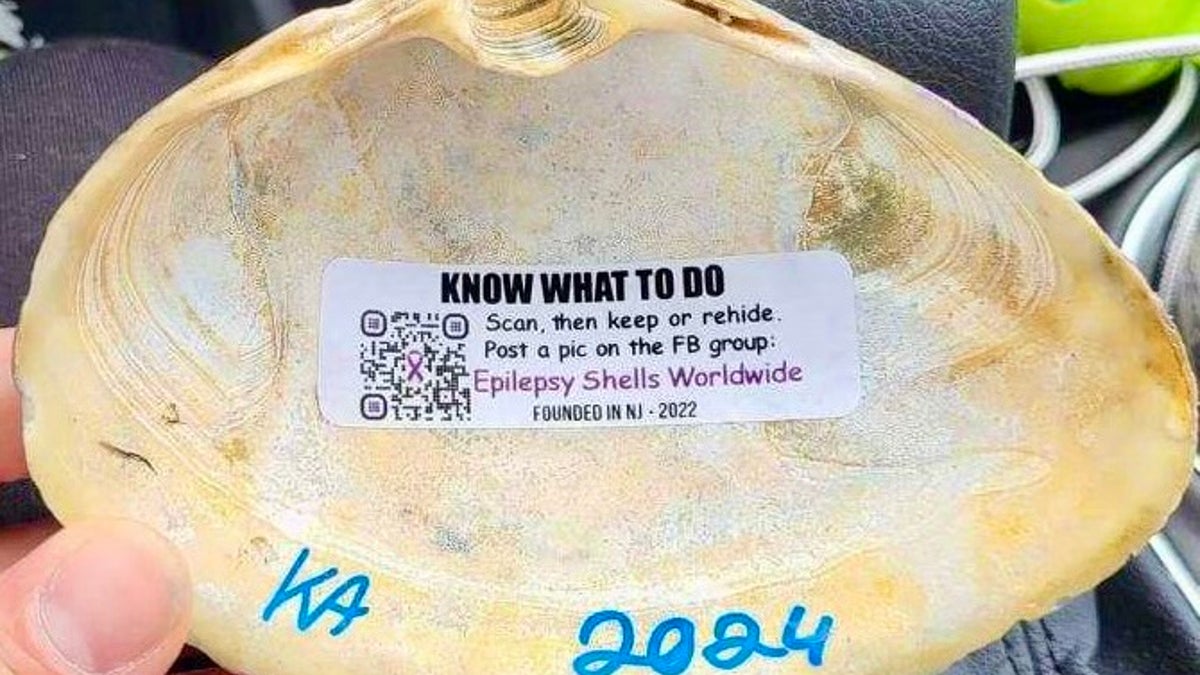
Each shell contains a QR code that a person can scan to access information, resources and fundraisers for epilepsy. (Adamkiewicz family)
In a way, Rozman said, Adamkiewicz is turning his epilepsy into a good thing.
“It’s beneficial on both sides — for raising awareness and also allowing Kyle to have more control and to drive the story,” he said.
CLICK HERE TO SIGN UP FOR OUR HEALTH NEWSLETTER
“It can be such a devastating thing to have to deal with on a daily basis, and having some sort of license and control over that is really important.”
Adamkiewicz agreed that his project has been a therapeutic endeavor for him.
“We want to teach people how to be kind, and how to help.”
“If it’s been a really bad day, that’s mostly what I’ll be doing,” he said.
“Like earlier today, I was painting some shells and had my ear buds in, just listening to some music. I’m just so focused on painting the shells that I zone everybody else out.”
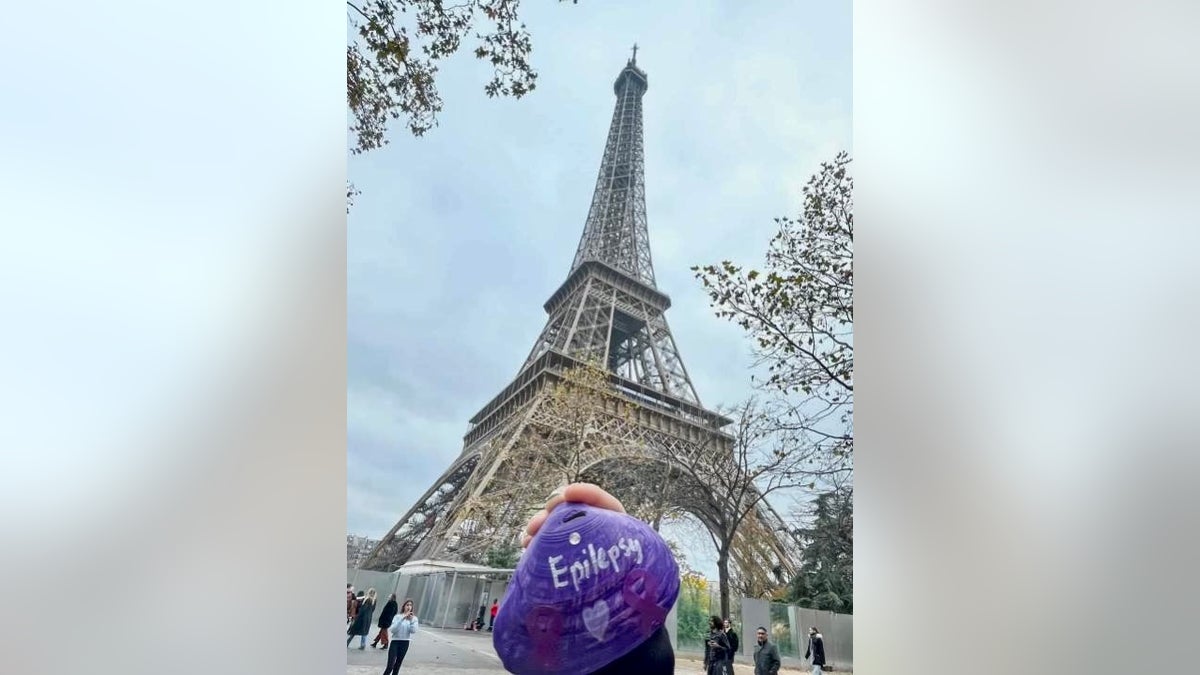
Adamkiewicz’s shells have been found in many cities and countries around the world, including in Paris, France. (Adamkiewicz family)
Adamkiewicz and his mother are also working on a children’s book to teach kids more about epilepsy and what to do if someone is having a seizure.
“When someone has a seizure, it can be frightening to other children,” said Laurie Adamkiewicz mother.
For more Health articles, visit www.foxnews/health
“So the goal is to get some information out there, to take the stigma away from the person who has epilepsy … We want to teach people how to be kind, and how to help.”
World News
26,000 Evacuate as Wildfire Spreads in Northern California

When a fast-moving wildfire began marching across thousands of acres of Butte County on Tuesday, David Pittman didn’t panic. He packed up his family, including their 90-pound African sulcata tortoise, and drove to his sister’s house across town in Oroville, Calif.
That’s where he’s planning to stay for the next several days — at least until firefighters get a handle on the Thompson fire, which has engulfed several homes and vehicles and has prompted about 26,000 people to evacuate, including Mr. Pittman.
“I hate to say it, but we’re experienced in this kind of stuff,” he said on Wednesday.
Mr. Pittman, 70, is the mayor of Oroville, a small Northern California town that has roots in the Gold Rush and is tucked near the state’s second-largest reservoir about 65 miles north of Sacramento. He is also a retired local fire chief who has watched his region face calamity after calamity in recent years.
In 2017, officials ordered residents to flee Oroville as thundering rapids from an emergency spillway at nearby Oroville Dam threatened to overwhelm the town. The next year, in 2018, one of the deadliest wildfires in American history, the Camp fire, killed 85 people and nearly wiped the town of Paradise — about 20 miles north of Oroville — off the map.
In 2020, a record-breaking fire season left millions of acres scorched across California, including “right into the city of Oroville,” Mr. Pittman said. In 2021, the second largest fire ever recorded in California, the Dixie fire, burned an area larger than New York, Los Angeles, Chicago and Dallas combined. It was sparked by damaged PG&E power lines near the waterway that bisects Oroville, the Feather River.
The various disasters, experts have said, are symptoms of widening climate extremes, which have plunged the West into near-constant whiplash between catastrophic floods and raging wildfires. This year, climate scientists warned that a hot summer in the West could dry out vegetation that grew abundant during a wet winter, turning what was lush green into prime tinder and making for a hazardous fire season.
For many Oroville residents at evacuation centers on Wednesday, fleeing from wildfires is becoming routine.
Sitting in the 106 degree heat outside a church shelter a few miles from the fire, Vernon Englund, 78, said this was the third time he had evacuated in four years from fires.
“We’ve been evacuated enough times that we keep to-go bags, and I just hooked up my R.V. and took off,” he said. “But I probably should have been more worried than I was, because the fire got closer than I ever thought that it would,” he added.
For Ashlie Boocks, 22, who had driven to the church shelter on Tuesday after seeing “ash the size of my palm” drifting from the sky, this was her second evacuation in three years.
On Tuesday night, she said, she drove to a spot where she could see the whole mountainside glowing with flames. “It was lit up and it was just horrible,” she said. “You’re seeing propane tanks exploding. You can hear them.”
“This is not something that should be common,” she added.
Pacific Gas & Electric, California’s biggest power utility, shut off power this week in some parts of Northern California, including Butte County, because of the increased fire risk, including nearly 2,000 homes and businesses in eight counties on Tuesday, The Sacramento Bee reported.
The Thompson fire, which erupted on Tuesday morning, remains small compared with the major fires in past years; as of Wednesday night, it had burned nearly 3,600 acres of mountainous terrain near Lake Oroville and was 7 percent contained, according to Cal Fire, the state’s firefighting agency. So far, eight injuries have been reported as a result of the blaze. And the authorities have not yet said how many structures have been damaged, though the fire has consumed homes and vehicles, based on news coverage.
Several state water facilities were affected by the evacuation orders, but there was no risk to Oroville Dam, which is the tallest dam in the United States, the California Department of Water Resources said on Tuesday night.
Mr. Pittman noted that the extreme heat baking the state this week, along with unpredictable winds, would make containing the blaze particularly difficult. Temperatures in Oroville were expected to reach 110 degrees on Wednesday and even higher toward the end of the week, according to the National Weather Service.
“We have up-and-down breezes that are pushing the fire around,” he said. “The fuels are ready to burn. So the crews have a tough job.”
He added, “I’m standing outside, and I can feel the heat through my T-shirt.”
Evacuation centers were full, he said. A large fireworks display that typically draws more than 10,000 people to Oroville was canceled to ensure that emergency workers could focus on responding to the fire.
Oroville officials on Wednesday temporarily banned the use of fireworks of any kind in the city, but stopped short of prohibiting legal sales, which local nonprofit groups have long used to raise funds in the summer. In Butte County, fireworks are illegal except in the cities of Oroville, Gridley and Biggs, where those with a “safe and sane” seal can be used.
“The last thing we need is somebody who’s purchased fireworks from a local fire stand going out and doing something stupid,” Sheriff Kory Honea of Butte County said at a news conference late Tuesday. “Don’t be an idiot, cause a fire and create more problems for us.”
Fireworks may not be as visually impressive as usual, anyway: The mayor said that the smoke in downtown Oroville was at one point so thick that he couldn’t see his hand in front of his face. Some evacuees have gathered there with trailers or recreational vehicles, but many businesses were closed.
Brian Wong said that his restaurant, Union Patio Bar and Grill, would remain open with reduced staffing because workers were dealing with their own evacuation orders. Evacuees would receive a discount, he said.
“We’ll just do what we can,” he said. “Today is about serving the community.”
But Mr. Wong, 53, said he wouldn’t be on site. Instead, he plans to stay at his home with his father-in-law, where they hope to protect the property by extinguishing any flames that get close.
Although his house is under an evacuation order and most of his neighbors have fled, Mr. Wong said that he was reluctant to do so after seeing residents of Paradise and other communities struggle to obtain insurance payments or other emergency aid.
“A lot of those cases are still not settled,” he said. “A lot of people that have properties — they’re not going to get what they were owed. So I really didn’t want to leave.”
He added that many of his neighbors had been required to pay skyrocketing insurance premiums, while others had simply gone uninsured as companies dropped coverage in many areas of California.
Mr. Wong, who has lived full-time in Oroville for more than 25 years, said that he and his family had taken precautions recommended by fire experts to clear brush on the property. He had also packed his truck full of valuables and said he was ready to leave if necessary.
Still, as of Wednesday afternoon, he was hunkering down and watching the plumes of smoke, hoping that his neighborhood would be spared.
Amanda Holpuch, Jonathan Wolfe and Yan Zhuang contributed reporting.
World News
‘I’m running’, Biden says, as pressure mounts on campaign

By Gareth Evans and Kayla Epstein, BBC News, Washington & New York
 EPA
EPAUS President Joe Biden worked to calm senior Democrats and staff on his campaign on Wednesday, as reports suggested he was weighing his future after his disastrous debate with Donald Trump last week.
Mr Biden held a closed-door lunch with Vice-President Kamala Harris at the White House as speculation mounted over whether she would replace him as the party’s candidate in November’s election.
The pair then joined a call with the broader Democratic campaign where Mr Biden made clear he would remain in the race and Ms Harris reiterated her support. “I’m the nominee of the Democratic Party. No one’s pushing me out. I’m not leaving,” he told the call, a source told BBC News.
That same phrase was repeated in a fundraising email sent out a few hours later by the Biden-Harris campaign. “Let me say this as clearly and simply as I can: I’m running,” Mr Biden said in the email, adding that he was “in this race until the end”.
Questions have been swirling around whether the 81-year-old will continue with his campaign following the debate with Trump, which was marked by verbal blanks, a weak voice and some answer which were difficult to follow. It sparked concern in Democratic circles around his fitness for office and his ability to win the election.
Pressure on Mr Biden to drop out has only grown in the days since as more polls indicate his Republican rival’s lead has widened. A New York Times poll conducted after the debate, which was published on Wednesday, suggested Trump was now holding his biggest lead yet at six points.
And a separate poll published by the BBC’s US partner CBS News suggested Trump has a three-point lead over Biden in the crucial battleground states. That poll also indicated the former president was leading nationally.
The damaging polling has been compounded by some Democratic donors and lawmakers publicly calling on the president to stand aside. Ramesh Kapur, an Indian-American industrialist based in Massachusetts, has organised fundraisers for Democrats since 1988.
“I think it’s time for him to pass the torch,” Mr Kapur told the BBC. “I know he has the drive, but you can’t fight Mother Nature.”
And two Democrats in Congress also called for a change at the top of the party’s ticket. The latest, Representative Raul Grijalva of Arizona, told the New York Times it was time for Democrats to “look elsewhere”.
Despite this, the White House and the Biden campaign have vehemently denied reports he is actively weighing his future and say he is committed to defeating Trump for a second time on 5 November.
The New York Times and CNN reported on Wednesday that Mr Biden had told an unnamed ally he was evaluating whether to stay in the race.
Both reports said the president had told the ally he was aware his re-election bid was in danger and his forthcoming appearances – including an ABC News interview and a Friday rally in Wisconsin – were hugely important to his campaign.
A spokesperson rejected the reports as “absolutely false”, shortly before White House Press Secretary Karine Jean-Pierre faced a barrage of questions about Mr Biden’s commitment to the race.
She said the reports he may drop out were untrue: “We asked the president [and] the president responded directly… and said ‘no, it is absolutely false’. That’s coming direct from him.”
Mr Biden met 20 Democratic governors from around the country, including California’s Gavin Newsom and Michigan’s Gretchen Whitmer, later on Wednesday. Both have been tipped as potential replacements if Mr Biden were to stand aside.
“The president has always had our backs, we’re going to have his back as well,” Maryland Governor Wes Moore told reporters after the meeting.
New York Governor Kathy Hochul said the two dozen governors who had just met the president pledged their support and that Mr Biden had vowed he was “in it to win it”.
But Ms Harris is still considered the most likely replacement. The 59-year-old has been hampered by poor approval ratings, but her support has increased among Democrats since the Biden-Trump debate.
The vice-president gave an immediate interview on CNN after the debate, projecting calm as she expressed full support for the president.
“She’s changing nothing,” a source close to Ms Harris told BBC News, adding that she would continue to hit the road on behalf of the campaign.
“She has always been mindful to be a good partner to the president,” said Jamal Simmons, Ms Harris’ former communications director.
“The people who ultimately will make the decision about who the nominee should be mostly are people who are pledged to him. Her best role is to be a partner to him.”
Members of the Democratic National Committee are charged with voting to officially make President Biden the party’s nominee at the August convention, putting him on the ballot nationwide.
One member, who has spoken to other delegates and requested anonymity to speak frankly about sensitive discussions, told the BBC that the nomination should go to Vice-President Harris if Mr Biden opted not to run.
“If we open up the convention, it will cause pure chaos that will hurt us in November,” they said.
A report by the Washington Post, meanwhile, said Mr Biden and his team recognised that he must demonstrate his fitness for office in the coming days.
He appeared at a Medal of Honor ceremony on Wednesday, and has planned trips to Wisconsin and Philadelphia later in the week.
Courtney Subramanian, Adam Levy and Brajesh Upadhyay contributed to this report
-

 African History5 years ago
African History5 years agoA Closer Look: Afro-Mexicans 🇲🇽
-

 African History5 months ago
African History5 months agoBlack History Facts I had to Learn on My Own pt.6 📜
-

 African History5 years ago
African History5 years agoA Closer Look: Afro-Mexicans 🇲🇽
-

 African History1 year ago
African History1 year agoMajor African Tribes taken away during the Atlantic Slave Trade🌍 #slavetrade #africanamericanhistory
-

 African History1 year ago
African History1 year agoCameroon 🇨🇲 World Cup History (1962-2022) #football #realmadrid #shorts
-

 African History5 months ago
African History5 months agoBlack History Inventors: Mary Kenner 🩸
-

 African History1 year ago
African History1 year agoPROOF AFRICAN AMERICANS AIN'T FROM AFRICA DOCUMENTED EVIDENCE
-

 African History1 year ago
African History1 year agoNo African pre-Columbus DNA? 🤯🤯 #history #mesoamerica #mexico #african

























